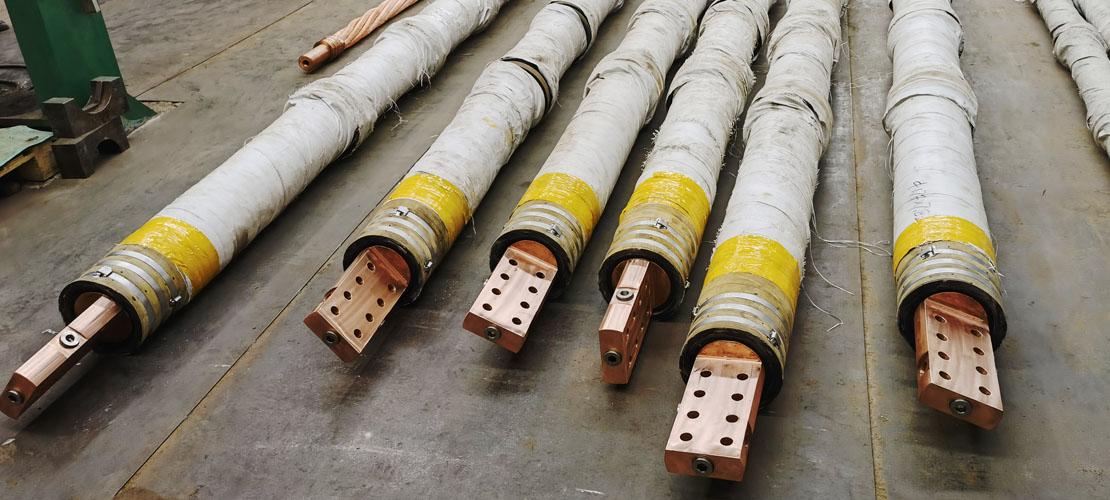Jan. 17, 2025

Water-cooled cable is a special type of cable that is widely used for power transmission in high-temperature environments, such as electric furnaces and arc furnaces in the metallurgical industry.
Cooling water pipe: located in the center of the cable, used to circulate cooling water to help reduce the heat generated by the cable when working under high load.
Conductor: arranged around the cooling water pipe, responsible for the transmission of electrical energy.
Rubber tube: surrounds the conductor, provides insulation protection, and prevents moisture and other external environmental factors from damaging the conductor.
Shielding layer: the first layer outside the rubber tube, usually composed of metal braided mesh or foil, used for electromagnetic interference shielding.
Insulation layer: located outside the shielding layer, provides additional thermal protection to ensure that the cable works stably in high-temperature environments.
Metal jacket layer: the outermost layer, usually a metal corrugated tube, not only provides physical protection, but also has good heat resistance and aging resistance, while preventing sparks from splashing onto the cable.
Due to its special structure and use, water-cooled cables are different from ordinary cables in fault judgment.
The following is a detailed analysis of the above example and additional notes:
After the arc furnace has finished feeding the secondary material, the switch is turned on for smelting. No arc is seen on electrode No. 2 (V phase), and arc can be seen on electrodes No. 1 (W phase) and No. 3 (U phase), but the arc light is weak.
The cross-section of the V-phase water-cooled cable is large (3500 square millimeters), and two cables are arranged in parallel. It is generally believed that the possibility of the two cables being short-circuited at the same time is very small.
Adjust the secondary voltage of the arc furnace transformer to 360V, close the switch, and first use a multimeter to measure the V-phase secondary voltage, which is a normal value;
However, this value is the measurement value when there is no large current, and it does not mean that the cable is intact (because the resistance value of the large-section water-cooled cable does not necessarily become infinite after the circuit is broken. If there is still a resistance of several thousand ohms, the voltage drop is very small for instruments with high internal resistance such as multimeters, so the multimeter will show a basically normal voltage).
To this end, it is necessary to install a test load before testing (because after adding a high-power load to the broken water-cooled cable, the resistance of several thousand ohms on the line almost reduces the voltage, and the multimeter can display abnormal voltage).
For example, two 500W bulbs are connected in series and installed on the conductive cross arm, and the switch is turned on. If the bulb does not light up, then the V phase voltage is measured at this time, and there is no reading, indicating that both cables are broken.
The power of the test load should be large enough to ensure that a certain current passes through the water-cooled cable, which is conducive to fault diagnosis.
Before conducting a load test, the secondary voltage of the arc furnace transformer should be adjusted to below 400V to avoid safety risks caused by excessive voltage.
In summary, the method of quickly judging the water-cooled cable circuit breaker fault mainly includes: first use a multimeter to measure the secondary voltage to exclude other possibilities; then judge whether the cable is broken by installing a test load and observing whether the bulb is lit. During the operation, it is necessary to pay attention to selecting the appropriate test load power and adjusting the transformer secondary voltage to a safe range.
Latest News
Latest Products
Customized metallurgical machinery and equipment range: Electric Arc Furnace, Submerged Arc Furnace, LF Refining Furnace, Vacuum Furnace, Induction Furnace, Dust Remove System, Water Treatment Equipment, etc. Providing the most advanced equipment integration services, metallurgical equipment can be customized according to different needs of customers, and production capacity can be adjusted according to customer requirements.
Electric Arc Furnace
Submerged Arc Furnace
LF Refining Furnace
VD / VOD Vacuum Refining Furnace
Induction Furnace
Furnace Accessories
Navigation
E-mail: anna@srfurnace.com
Tel: +86 159 2955 5868
WhatsApp: +86 159 2955 5868
Add:
Room 102, Building 7A, Free Trade Xintiandi, Fengdong Avenue, Fengdong New Town, Xi'an City, Shaanxi Province
